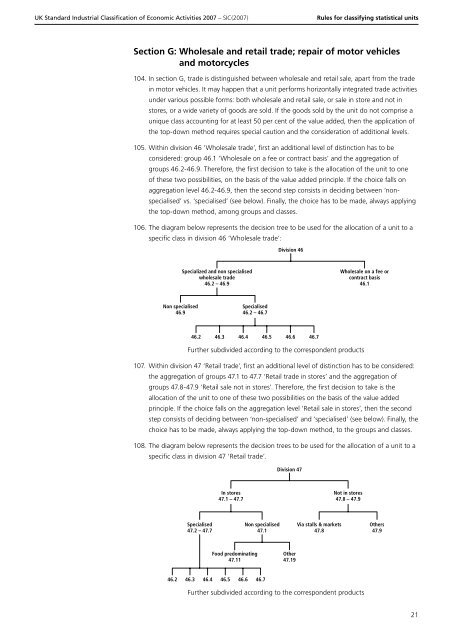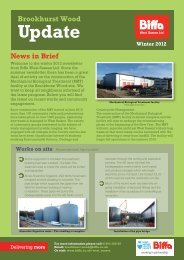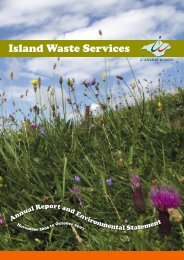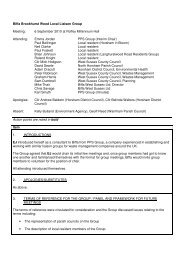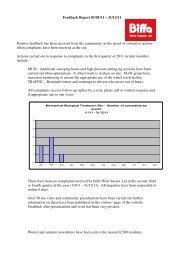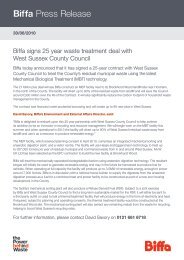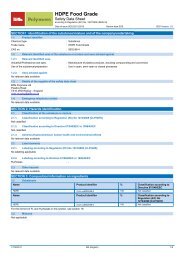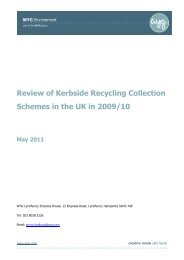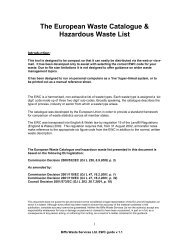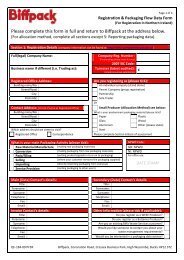detailed explanation for each SIC code - Biffa
detailed explanation for each SIC code - Biffa
detailed explanation for each SIC code - Biffa
Create successful ePaper yourself
Turn your PDF publications into a flip-book with our unique Google optimized e-Paper software.
UK Standard Industrial Classification of Economic Activities 2007 – <strong>SIC</strong>(2007)<br />
Rules <strong>for</strong> classifying statistical units<br />
Section G: Wholesale and retail trade; repair of motor vehicles<br />
and motorcycles<br />
104. In section G, trade is distinguished between wholesale and retail sale, apart from the trade<br />
in motor vehicles. It may happen that a unit per<strong>for</strong>ms horizontally integrated trade activities<br />
under various possible <strong>for</strong>ms: both wholesale and retail sale, or sale in store and not in<br />
stores, or a wide variety of goods are sold. If the goods sold by the unit do not comprise a<br />
unique class accounting <strong>for</strong> at least 50 per cent of the value added, then the application of<br />
the top-down method requires special caution and the consideration of additional levels.<br />
105. Within division 46 ‘Wholesale trade’, first an additional level of distinction has to be<br />
considered: group 46.1 ‘Wholesale on a fee or contract basis’ and the aggregation of<br />
groups 46.2-46.9. There<strong>for</strong>e, the first decision to take is the allocation of the unit to one<br />
of these two possibilities, on the basis of the value added principle. If the choice falls on<br />
aggregation level 46.2-46.9, then the second step consists in deciding between ‘nonspecialised’<br />
vs. ‘specialised’ (see below). Finally, the choice has to be made, always applying<br />
the top-down method, among groups and classes.<br />
106. The diagram below represents the decision tree to be used <strong>for</strong> the allocation of a unit to a<br />
specific class in division 46 ‘Wholesale trade’:<br />
Division 46<br />
Specialized and non specialised<br />
wholesale trade<br />
46.2 – 46.9<br />
Wholesale on a fee or<br />
contract basis<br />
46.1<br />
Non specialised<br />
46.9<br />
Specialised<br />
46.2 – 46.7<br />
46.2 46.3 46.4 46.5 46.6 46.7<br />
Further subdivided according to the correspondent products<br />
107. Within division 47 ‘Retail trade’, first an additional level of distinction has to be considered:<br />
the aggregation of groups 47.1 to 47.7 ‘Retail trade in stores’ and the aggregation of<br />
groups 47.8-47.9 ‘Retail sale not in stores’. There<strong>for</strong>e, the first decision to take is the<br />
allocation of the unit to one of these two possibilities on the basis of the value added<br />
principle. If the choice falls on the aggregation level ‘Retail sale in stores’, then the second<br />
step consists of deciding between ‘non-specialised’ and ‘specialised’ (see below). Finally, the<br />
choice has to be made, always applying the top-down method, to the groups and classes.<br />
108. The diagram below represents the decision trees to be used <strong>for</strong> the allocation of a unit to a<br />
specific class in division 47 ‘Retail trade’.<br />
Division 47<br />
In stores<br />
47.1 – 47.7<br />
Not in stores<br />
47.8 – 47.9<br />
Specialised<br />
47.2 – 47.7<br />
Non specialised<br />
47.1<br />
Via stalls & markets<br />
47.8<br />
Others<br />
47.9<br />
Food predominating<br />
47.11<br />
Other<br />
47.19<br />
46.2 46.3 46.4 46.5 46.6 46.7<br />
Further subdivided according to the correspondent products<br />
21


